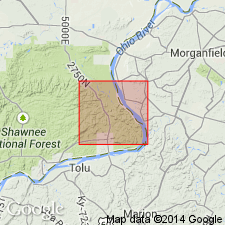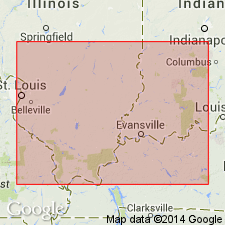
- Usage in publication:
-
- Walche Member
- Modifications:
-
- First used
- AAPG geologic province:
-
- Illinois basin
Summary:
Walche Member is basal member of Menard Limestone. Consists of dark-gray argillaceous fossiliferous limestone. Thickness commonly 3 to 8 ft. Separated from overlying Scottsburg Member (new) by 5 to 7 ft of shale. Overlies Waltersburg Formation. Name credited to Swann (in prep).
Source: GNU records (USGS DDS-6; Reston GNULEX).

- Usage in publication:
-
- Walche Limestone Member
- Modifications:
-
- Named
- Dominant lithology:
-
- Limestone
- AAPG geologic province:
-
- Illinois basin
Summary:
Name formally proposed in this report for lowest and thinnest of three main limestone members of Menard Formation of Elviran age, commonly called "little Menard." Overlies Waltersburg Formation. Separated from middle or Scottsburg Limestone Member of Menard by 3 to 30 ft of shale. Thins northward from outcrop along southern margin of Illinois basin and is absent north of irregular boundary near base line in IL that swings southeastward across IN to central part of Meade Co. KY. Thickness at type exposure in Caldwell Co. 14.5 ft. Age is Late Mississippian.
Source: GNU records (USGS DDS-6; Reston GNULEX).
For more information, please contact Nancy Stamm, Geologic Names Committee Secretary.
Asterisk (*) indicates published by U.S. Geological Survey authors.
"No current usage" (†) implies that a name has been abandoned or has fallen into disuse. Former usage and, if known, replacement name given in parentheses ( ).
Slash (/) indicates name conflicts with nomenclatural guidelines (CSN, 1933; ACSN, 1961, 1970; NACSN, 1983, 2005, 2021). May be explained within brackets ([ ]).

